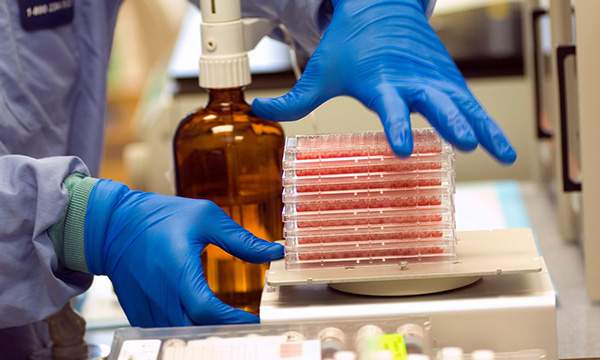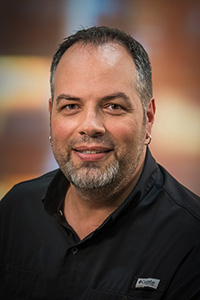
“You pull a squeegee, flattening the ink across the screen, so it creates an image on the shirt below. There’s a definite feel to the right way,” says Torrance (Tory) Meyer, a training specialist and technologist II in the Molecular and Infectious Disease (MID) Laboratory.
He’s talking about silk-screening shirts in high school, where he first picked up his teaching skills. New employees could ruin several shirts before gaining the knack—so Meyer learned to make his analogies clear, to save a shirt or two. While he has since forgotten those analogies (if not how to silk-screen), they stuck in people’s minds at the time, he says. “The experience showed me that effective training should include strong examples.” There’s also a definite feel to running assays, he notes.

Torrance (Tory) Meyer is a training specialist and technologist II in the Molecular and Infectious Disease (MID) Laboratory at ARUP.
How did you get started in scientific training?
In an undergraduate anatomy class, if you finished in a top certain percentage of the class, you could be a teaching assistant (TA). I made it, and went on to be a TA in the cadaver lab for my whole undergrad career. I realized I really liked teaching. After college, I lectured and taught anatomy and pathology at some of the local vocational schools for nearly 10 years.
What do you do?
I’m primarily a technologist II, so I run assays. But in my secondary work as a training specialist, I develop quizzes and I teach fellows and pathology students. The three labs within MID run more than 40 tests; a new employee needs to learn each one. I also help track the compliance tests we run to prove each lab’s efficacy at performing particular assays. Those take place twice a year.
Torrance (Tory) Meyer“Once you learn to take, for instance, a respiratory swab or spinal fluid and extract the nucleic acid out of it, you can do that for most assays. That is, when you’ve learned how to extract herpes, you can also extract adenovirus (a common cause of respiratory illnesses), parvovirus (more commonly a rash caused by respiratory secretions), and others.”
Training Specialist and Technologist II
How would you describe some of your training?
If an employee is new, they’ll be connected at the shoulder with me for a month. I demonstrate practice runs on practice samples, and we perform multiple runs of an assay. If they perform well or pretty well, we move on to doing clinical samples. They need to train on each assay that we’ll perform in that lab. Once you learn to take, for instance, a respiratory swab or spinal fluid and extract the nucleic acid out of it, you can do that for most assays . That is, when you’ve learned how to extract herpes, you can also extract adenovirus (a common cause of respiratory illnesses), parvovirus (more commonly a rash caused by respiratory secretions), and others. If someone is in training for an assay, they need to score 100 percent on their analysis in order to qualify and begin performing that test clinically. There’s definitely no 80 percent, in the lab.
Is training sometimes automated?
Because we’re a 24/7 laboratory and I work in the daytime, some techs who work graveyard shift have taken over training at night. My goal is to try to automate that process as much as possible. That way, if an employee wants to train alone, they can open an Excel document (with interactive links) and observe the instructions there. For some assays, those trainings are already available on spreadsheets; we’ve set them up. If an employee already knows one assay, in most cases they can learn another one easily by using a spreadsheet as most of our assays are very similar. If they want to train then on the assay for herpes simplex virus, they may not need my direct help if they are already familiar with other MID assays.
What keeps you interested?
I honestly don’t get bored because each person is different. I like not only finding out what will help each individual learn, but also bringing them what I’ve learned from previous teaching sessions.
I begin training employees to do extractions, but as time goes on, they’ll need to learn how to analyze the results they get from their extraction. Most of the continued training is on the analysis. However, most of the analysis is very similar between assays. It’s like getting a driver’s license for cars, then obtaining specialties in motorcycles, stretch limos; once you’ve learned one, the others aren’t that different.
How does the work evolve?
As a technologist, I’d say that when I was new, I thought that after a year of running assays, I’d reach a point where I knew everything. But the laboratory is so complex, and the instrumentation is so complicated, that I’m always learning something.
In conclusion?
I’d say this: I don’t do any of the work alone. Others help me by coding the interactive Excel spreadsheet or handling other matters. New workers come up to me and say the training was great, but I’m leery of accepting full praise—because truly, there are so many people who make it happen.
Catherine Arnold, Science Communications Writer
















